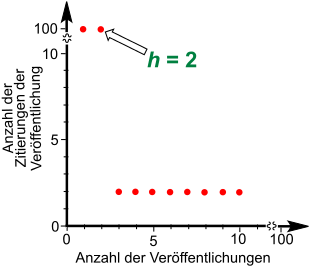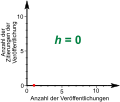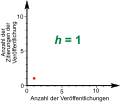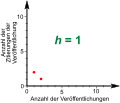h index
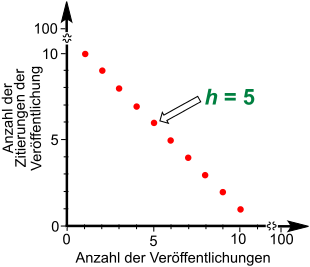
The h index is a key figure for the worldwide reputation of a scientist in specialist circles. The key figure is based on bibliometric analyzes, i.e. H. on citations of the scientist's publications . A high h index results when a considerable number of the scientist's publications are frequently cited in other publications. The physicists of the 2005 Jorge E. Hirsch proposed evaluation index is sometimes referred to as Hirsch index , Hirsch factor , Hirsch coefficient or h-number designated.
The h index of a scientist can not sink over time; on the other hand, it cannot increase solely through the number of its publications.
definition
A scientist's index was defined as the [largest possible] number of publications by this scientist that were cited at least times.
This always refers to the largest number that meets this requirement. The following definition is therefore equivalent to this: A scientist has a Hirsch index if his publications have been cited at least three times and the remaining publications at most three times.
To determine all of the author's publications, you can order them according to the frequency of citation in descending order and then count until the th publication has fewer than number of citations. Then is .
According to Hirsch, an H-index of 20 after 20 years of research is the sign of a successful scientist. An H-index of 40 after 20 years of research activity indicates the extraordinary scientist who can probably only be found in top universities and large research laboratories. According to Hirsch, only unique personalities had an H index of 60 and higher after 20 years of research activity.
Examples of calculation
Some examples from authors with 10 publications each:
- With quotation frequencies 10, 9, 8, 7, 6, 5, 4, 3, 2, 1, the Hirsch factor is 5, because five publications were cited at least five times, the rest at most five times. The sixth publication was also cited five times, but it cannot be counted because this would increase the Hirsch factor to 6 and five citations would no longer be sufficient.
- If the quotation frequency is 100, 100, 2, 2, 2, 2, 2, 2, 2, 2, the Hirsch factor is 2, because two publications were cited at least twice, the rest at most twice.
- If the quotation frequency is 100, 100, 9, 8, 3, 2, 2, 1, 1, 0, the Hirsch factor is 4 because four publications were cited at least four times, the rest at most four times.
Example over time
backgrounds
The h -Index for evaluating scientific achievements was proposed in 2005 by the Argentine physicist Jorge E. Hirsch in the Proceedings of the National Academy of Sciences .
A wide variety of data sources that provide evidence of citations are conceivable as the data basis for calculating this bibliometric indicator . Hirsch himself suggested that the data from the Web of Science should be used to a large extent , as this represented the most reliable and comprehensive database at the time.
The h -index can now be found in many citation databases, e.g. B. in Google Scholar , if the author has a profile.
Example with different databases
Using the example of the theoretical physicist Stephen W. Hawking , the influence of the database used to determine the h-index can be clearly illustrated. The data was collected on June 15, 2017:
| Database | Number of publications | Total number of citations | h index |
|---|---|---|---|
| Google Scholar | 908 | 121,425 | 118 |
| Scopus | 148 | 29,985 | 66 |
| Web of Science CC | 179 | 37,484 | 78 |
development
The h index is not only used as a key figure for authors, but also for institutions, working groups, countries or magazines. Variants are also used for certain purposes (see below).
properties
The h -index has some advantages over other key figures (such as the total number of citations by an author or the impact factor ), since the citations of a single, much-cited publication do not have a major influence on the index. However, this can also be interpreted as a disadvantage, since possibly groundbreaking articles are not appropriately appreciated (there is almost a harmonious alignment of the evaluation of the quotations). In addition, neither the number of co-authors nor the fact whether the cited publication is an original work or a review article is taken into account . In general, it should be noted that citations measure the (differently justified) "popularity" and not necessarily the scientific relevance of a publication; for example, Évariste Galois, who died early, would have had an h -index of 2 despite his fundamental work in mathematics , and Albert Einstein would have had an h -index of 4 after the Annus Mirabilis .
In principle, young researchers have lower h indices than older researchers in the same subject because they have published even less. In subjects in which less is published and cited, the h -indices are lower than in subjects with high output. Although high productivity is not necessarily rewarded with a higher index, the maximum h -index can be as high as the number of publications.
Problems
The collection of the basic data represents a great difficulty. With the data basis proposed by Hirsch (Web of Science by Thomson Reuters ), among other things, book publications are poorly recorded, which has a strong influence on the results of the survey. In the social sciences and humanities in particular, further publications such as For example, book reviews can be significant without being cited frequently and thus included in the h -index. If, on the other hand, the survey is expanded to include an uncontrolled, larger database of scientific publications (e.g. Google Scholar), the h -index can be manipulated in a targeted manner through a lot of self-referencing and easily increased, as was demonstrated at the University of Grenoble in 2011 . Therefore, h -indices must always be given with the underlying database and the date of the survey. The delimitation of authors with the same name is also a problem. Correct allocation is achieved by using identifiers such as ORCID .
The importance that the h index and comparable bibliometric measures have for the career of scientists leads to optimization strategies that have a negative effect on scientific culture. For example, it can be expedient to split a publication into several parts and publish them individually, self-interest-oriented with self-citations. Another possible strategy is to form groups (“schools of thought”) of 10 to 15 scientists who set up their own journal or a similar publication organ and frequently quote one another in it. Citation circles are also a way to improve the personal factor. Groups of scientists come together who cite each other when publishing or consider the group members as co-authors for (foreseeable citable) publications . These practices can undermine the integrity of science. Accordingly, there are voices calling for the h -index to be removed or for the numerous deficits of the h -index to be corrected through changes.
Scientists with high h indices
Scientists with the highest h- indices according to Hirsch
At the time the Hirsch index was published, Edward Witten had the highest h index among physicists with 120 . Other well-known physicists achieved an h -index of 62 to 107. For researchers in biology and biomedicine, Hirsch also calculated an h -index based on the citations from 1983 to 2002 . Solomon H. Snyder had the highest h -index of this subject group from this period with 191, the following 9 researchers in the ranking had h -indices from 160 to 120.
Examples of h indices 2019
The following examples reflect the status on August 18, 2019 according to the Scopus database .
| Surname | Number of publications recorded | Total number of citations | h index | source |
|---|---|---|---|---|
| Stephen Hawking | 163 | 41,180 | 75 | |
| Albert Einstein | 102 | 23,137 | 40 | |
| Edward Witten | 295 | 104,812 | 139 | |
| David Baltimore | 737 | 117,978 | 174 | |
| Ronald M. Evans | 545 | 127.205 | 174 | |
| Anthony Fauci | 1163 | 111,785 | 174 | |
| Carlo Maria Croce | 1271 | 156,455 | 186 | |
| Matthias Mann | 730 | 162,224 | 193 | |
| Robert Langer | 1697 | 188.996 | 214 | |
| Solomon H. Snyder | 1264 | 173.329 | 214 | |
| George Whitesides | 1360 | 220,538 | 222 | |
| Bert Vogelstein | 600 | 273,852 | 230 | |
| Michael Graetzel | 1567 | 285.941 | 244 |
literature
- JE Hirsch: An index to quantify an individual's scientific research output. In: Proceedings of the National Academy of Sciences . Volume 102, number 46, November 2005, ISSN 0027-8424 , pp. 16569-16572, doi: 10.1073 / pnas.0507655102 , PMID 16275915 , PMC 1283832 (free full text), arxiv : physics / 0508025 .
- JE Hirsch: An index to quantify an individual's scientific research output that takes into account the effect of multiple coauthorship. In: Scientometrics. 85, 2010, pp. 741-754, doi: 10.1007 / s11192-010-0193-9 . (also arxiv : 0911.3144 ).
- M. Richter: What does the h-index (not) measure? - Critical considerations for a popular research performance metric. In: WiSt - economics studies. Volume 47, Number 12, December 2018, pp. 64–68.
- A. Sidiropoulos, D. Katsaros, Y. Manolopoulos: Generalized h-index for Disclosing Latent Facts in Citation Networks. In: arXiv . 2006, arxiv : cs / 0607066 .
- P. Ball: Achievement index climbs the ranks. In: Nature. Volume 448, number 7155, August 2007, ISSN 1476-4687 , p. 737, doi: 10.1038 / 448737a , PMID 17700666 .
Web links
- Harzing.com - Publish or Perish Free analysis tool based on Google Scholar data to determine the Hirsch factor
- ISI Web of Knowledge - database containing the H-Index evaluation (access only after registration or e.g. via campus logins)
- SCImagojr.com - H-Index for magazines (not at individual level)
- The h-index - calculation and meaning of the bibliometric index , video tutorial (German)
Individual evidence
- ↑ a b c d J. E. Hirsch: An index to quantify an individual's scientific research output. In: Proceedings of the National Academy of Sciences . Volume 102, number 46, November 2005, ISSN 0027-8424 , pp. 16569-16572, doi: 10.1073 / pnas.0507655102 , PMID 16275915 , PMC 1283832 (free full text), arxiv : physics / 0508025 .
- ↑ Wrong researcher identity - do you know Ike Antkare? taz.de, March 3, 2011.
- ↑ The Hirsch Index (PDF file; 23 kB).
- ↑ Interview with Prof. Dr. Ludwig Winnacker: You do anything for an article in Science. Retrieved January 6, 2019 .
- ^ Rowlands I: Is it time to bury the h-index? March 28, 2018, accessed January 9, 2019 .
- ↑ Batista PD, Mônica G. Campiteli, Osame Kinouchi: Is it possible to compare researchers with different scientific interests? . In: Scientometrics . 68, No. 1, 2006, pp. 179-189. doi : 10.1007 / s11192-006-0090-4 .
- ↑ Antonis Sidiropoulos, Katsaros, Dimitrios and Manolopoulos, Yannis: Generalized Hirsch h-index for disclosing latent facts in citation networks . In: Scientometrics . 72, No. 2, 2007, pp. 253-280. doi : 10.1007 / s11192-007-1722-z .
- ↑ Jayant S. Vaidya: V-index: A fairer index to quantify an individual's research output capacity . In: BMJ . 331, No. 7528, December 2005, pp. 1339-c-1340-c. doi : 10.1136 / bmj.331.7528.1339-c .
- ↑ D. Katsaros, A. Sidiropoulos, Y. Manolopous: Age Decaying H-Index for Social Network of Citations . In: Proceedings of Workshop on Social Aspects of the Web Poznan, Poland, April 27, 2007 . 2007.
- ^ TR Anderson, RKS Hankin, PD Killworth, Beyond the Durfee square: Enhancing the h-index to score total publication output . In: Scientometrics . 76, No. 3, 2008, pp. 577-588. doi : 10.1007 / s11192-007-2071-2 .
- ^ C. Baldock, Colin G. Orton, Ma, RMS and Orton, CG: The h index is the best measure of a scientist's research productivity . In: Medical Physics . 36, No. 4, 2009, pp. 1043-1045. bibcode : 2009MedPh..36.1043B . doi : 10.1118 / 1.3089421 . PMID 19472608 .
- ↑ Hawking, Stephen. In: Scopus preview - Scopus - Author details. Elsevier BV, accessed August 17, 2019 .
- ↑ Einstein, Albert. In: Scopus preview - Scopus - Author details. Elsevier BV, accessed August 17, 2019 .
- ↑ Witten, Edward. In: Scopus preview - Scopus - Author details. Elsevier BV, accessed August 17, 2019 .
- ↑ Baltimore, David. In: Scopus preview - Scopus - Author details. Elsevier BV, accessed August 17, 2019 .
- ↑ Evans, Ronald M. In: Scopus preview - Scopus - Author details. Elsevier BV, accessed August 17, 2019 .
- ↑ Fauci, Anthony S. In: scopus.com. Scopus , accessed March 22, 2020 .
- ↑ Croce, Carlo Maria. In: Scopus preview - Scopus - Author details. Elsevier BV, accessed August 17, 2019 .
- ^ Mann, Matthias. In: Scopus preview - Scopus - Author details. Elsevier BV, accessed August 17, 2019 .
- ^ Langer, Robert Samuel M. In: Scopus preview - Scopus - Author details. Elsevier BV, accessed August 17, 2019 .
- ^ Snyder, Solomon H. In: Scopus preview - Scopus - Author details. Elsevier BV, accessed August 17, 2019 .
- ^ Whitesides, GM In: Scopus preview - Scopus - Author details. Elsevier BV, accessed August 17, 2019 .
- ↑ Vogelstein, Bert. In: Scopus preview - Scopus - Author details. Elsevier BV, accessed August 17, 2019 .
- ↑ Grätzel, M. In: Scopus preview - Scopus - Author details. Elsevier BV, accessed August 17, 2019 .

